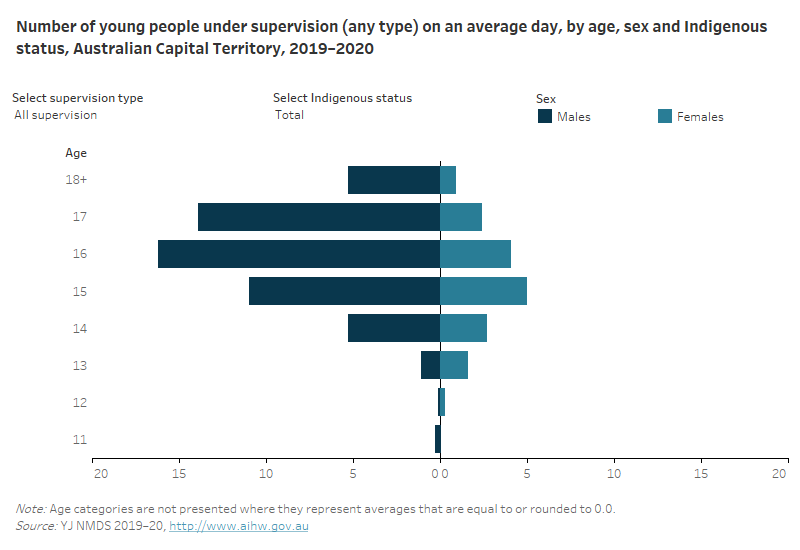Australian Capital Territory
Quick facts
On an average day in 2019–20, in the Australian Capital Territory:
- 70 young people aged 10 and over were under youth justice supervision
- 16 per 10,000 young people aged 10–17 were under supervision
- Indigenous young people were 9 times as likely as their non-Indigenous counterparts to be under supervision.
Of those under supervision in the Australian Capital Territory on an average day:
- 79% were supervised in the community, and the rest in detention
- 76% were male
- 22% of those aged 10–17 were Aboriginal or Torres Strait Islander
- 75% of those in detention were unsentenced (awaiting the outcome of their court matter or sentencing), and the rest were serving a sentence.
Young people spent an average of nearly 25 weeks under supervision during the year.
Over the 5 years to 2019–20, the number of young people under supervision on an average day fell slightly from 73 to 70, with a high of 103 in 2017–18.
Box: Impact of COVID-19 on youth justice data
This report includes data from the COVID-19 period, between March and June 2020. However, more data is required to determine the impact of COVID-19 on the youth justice system.
Number and rate
On an average day in 2019–20, in the Australian Capital Territory:
- 70 young people aged 10 and over were under youth justice supervision
- 79% were supervised in the community, and the rest (22%) in detention (the proportion of young people under community-based supervision and in detention may not sum to 100% as young people may have been under community-based supervision and in detention on the same day)
- the rate of supervision was 16 per 10,000 young people aged 10–17
- 13 per 10,000 young people aged 10–17 were under community-based supervision, and 3.6 per 10,000 were in detention.
Age and sex
On an average day in 2019–20, in the Australian Capital Territory:
- 91% of those under supervision were aged 10–17, and the rest were 18 and over
- just over 3 in 4 (76%) of those under supervision were male
- males under supervision were most likely to be aged 16, while females were most likely to be 15.

Box: Updated age calculation on an average day
For 2019–20, the age calculation for the average daily population has been changed. Age is now calculated based on the age a young person is each day that they are under supervision. If a young person changes age during a period of supervision, then the average daily number under supervision will reflect this. Due to this change in methodology, average daily data with an age selection or breakdown will not be comparable to previous Youth justice in Australia releases.
Aboriginal and Torres Strait Islander young people
On an average day in 2019–20, in the Australian Capital Territory:
- Indigenous young people made up 3% of those aged 10–17 in the general population, but 22% of those of the same age under supervision
- Indigenous young people aged 10–17 were 9 times as likely as non-Indigenous young people to be under supervision (120 per 10,000 compared with 13 per 10,000).
Time under supervision
In 2019–20, in the Australian Capital Territory:
- the median duration of supervision periods that were completed during the year was 60 days (nearly 9 weeks)
- when all time spent under supervision during the year is considered, young people spent an average of 172 days (almost 25 weeks) under supervision.
Sentenced and unsentenced detention
On an average day in 2019–20, in the Australian Capital Territory:
- 12 young people in detention were unsentenced—that is, they were awaiting the outcome of their court matter, or had been found guilty and were awaiting sentencing
- 4 young people in detention were serving a sentence.
Trends to 2019–20
Over the 5 years to 2019–20, on an average day in the Australian Capital Territory:
- the number of young people under supervision fell slightly from 73 in 2015–16 to 70 in 2019–20, peaking to 103 in 2017–18. The rate fell slightly from 17 to 16 per 10,000 young people aged 10–17, with a high in 2017–18 of 24 per 10,000
- in community-based supervision, the number fell by 15%, with a high in 2017–18, while the rate fell overall from 16 to 13 per 10,000, with a high of 23 per 10,000 in 2017–18
- in detention, the number rose from 8.5 to 16 young people, while the rate rose from 1.6 to 3.6 per 10,000
More information
For more information see Youth Justice.



